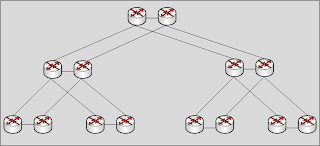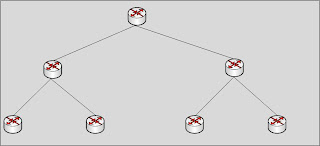VSS brings a much greater depth of virtualization to the switching layer and actually helps solve many of the challenges Network Engineers face when building out large switching environments. To put it in a nutshell, VSS allows an engineer to take two Cisco Catalyst 6500 series switching platforms and "virtualize" or collapse them so they appear to be one switch. Here is a basic diagram for how your layer two environment would normally appear for a highly redundant data center switching architecture:

VSS basically allows you to collapse each of these switch pairs into a virtual switch so your new high level architecture would look like this:
 From an engineering standpoint, this has several advantages and the new VSS technology combined with other technologies allows us to:
From an engineering standpoint, this has several advantages and the new VSS technology combined with other technologies allows us to:1) Cut down on the number of ports and links that are serving in a passive only capacity. In the past, one set of the redundant links were automatically implemented in a passive state thanks to Spanning Tree Protocol (STP). STP was originally designed to help prevent loops in the network but is now commonly implemented as a redundancy mechanism. By using VSS and another technology called Multichassis Etherchannel, you can basically get to a state where all links are active and passing traffic. This increases capacity, allows you to use ports and links previously unusable unless a failover occurred and allows you to cut down on the number of ports. Active/passive architectures only use 50% of available capacity, adding considerable expense to the project.
2) Manage fewer network elements. With VSS we get one control plane for each VSS cluster so these appear as one switch. One switch to manage instead of two has it's obvious benefits.
3) Use all NICs on the servers in the infrastructure. As with the combined links between the switches, you can also have combined links for the servers using the same technology. Multichassis Etherchannel (MEC) allows you to connect a server to two physically seperate switches and use both connections for an active/active implementation. This is a pretty big step in that we immediately double the capacity of our servers with the same number of NICs while still providing the highest level of redundancy.
4) Build bigger backbones. The performance of a VSS cluster is almost exactly twice that of one standalone 6500 platform. You might think this would be obvious being that you're using two switches so of course performance should be twice as much. But the fact that Cisco has managed to pull it off across two physically seperate chassis that appear as one logical switch is pretty amazing...at least from this engineer's perspective.
I think that's a good summary but this is some exciting stuff and will allow all of us engineers who have had our share of STP issues over the years some hope for the future!

Have you personally deployed this to any degree of success since the Orlando Networkers? What successful case studies have you seen? Can you share that?
ReplyDelete